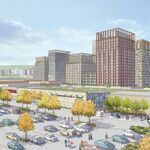See
@adys123 comments above.
But let me add; if you add a highway at edge of the urban area, particularly absent any other policy intervention, development, generally in the form of sprawl will follow.
We know this, locally, without academic papers, because this happened with the 401 and 407, with the 410 extension, with the 404 extension etc.
IF you don't want sprawl, then that would be a peculiar choice.
***
Additionally, you absolutely have to tie land-use to transportation; let me afford a hypothetical example:
So lets say you want to create a relatively walkable, transit-friendly community at the edge of suburbia.
How do you start?
Well, you start by saying where are the people who will live here likely to commute to? Then, how will they make that commute?
You would reference the nearest built up areas for cordon count surveys and origin-desitination pairs and you would establish (for argument's sake), these people will want to commute to Downtown Brampton, more than any other destination.
So you then need to ask, how will they get there? Is there a train line nearby? Does it offer passenger service, does it go where you need it to go, is there a station positioned where your community will go? If not, can you add one?
***
Once you've addressed commute patterns, you need to address non-work trips. (School, and Grocery being the two most common).
You need to know if the density of your proposed community will support frequent bus service to the school and grocery store and to the train station.
If that can't be achieved, then you're very constrained on meeting your goal; but it might be feasible if the entire community were within a 10 minute walk of the train station, and the grocery store and school within a block of same.
****
Put simply the way in which you site and build a community, or infrastructure is key to its success or failure in general, and equally key to sustainability.
No, they can request the province to make that change.
Towns cannot do this. Neither can regions; they can submit a request to the province.
Who considers this? Those are provincial highways, and their expansion is solely within the control of the province. A region or city may well be aware of the MTO's future plans for widenings, and can certainly offer input, but they have no statutory control.
The Greenbelt legislation does not expressly limit new/expanded highway corridors.
They did that, in part, because many of these new/widened highways were contemplated prior to the Greenbelt, and corridor had been reserved, and/or purchased sometime before.
They also left large areas outside of the Greenbelt that are within the GTA commuter shed.
Would I prefer they had placed real limits on new/expanded highway corridors? Sure, yes; but to be clear, any such limit would be a provincial law, which any future government could amend or repeal.
With the exception of laws embedded in or limited by the Constitution, nothing is beyond being altered, except by the limitations of politics.





